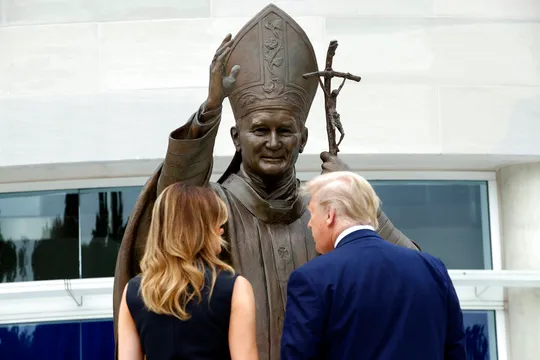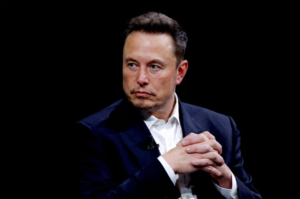Catholic University’s Perspective: Religious Imagery within Politics

Image Courtesy of Detroit News
By Anna Harvey & Jeremy Perillo
As waves of protests against racism continue to ripple across the United States, new questions arise regarding the role of politicians and religion amongst these protests. Politicians since the times of the Founding Fathers have referenced a deity or a religion in their speeches, mannerisms, and daily lives. Yet in recent years, as controversies arise over religion in political settings, a new conversation emerges over the acceptability of political religious references.
In particular, President Donald Trump has recently been heavily criticized for a photo op at St. John’s Church in downtown D.C. In order to gain access to the church, Trump walked through Lafayette Park, where protestors had assembled to protest racism following George Floyd’s murder. In order to clear the park and the area in front of the White House, police forces used aggressive force tactics to clear the area. A specific timeline of the event, as explained by the Washington Post, clearly reveals that the police used aggressive and violent force to clear the crowds, using tactics such as pepper ball guns, rubber bullets, and canister launchers. Consequently, President Trump’s photo op, where he stood in front of St. John’s Church while holding aloft a bible, was not well-received by the public.
Not long after President Trump’s photo op at the church, he made a second religious visit to the St. John Paul II Shrine, during which he documented additional religious photos. Given that the shrine is adjacent to the Catholic University of America’s campus, CUA alumni recently raised questions of how the university community views religious imagery within political contexts, particularly those of recent events.
Reflecting on the topic of religious imagery within politics, President Garvey advises the university community to view the subject in a constitutional light. He raises two specific questions, the first of which addresses whether the First Amendment forbids the president from praying, visiting churches or shrines, or reading the Bible. Put simply, it does not; while some Supreme Court cases do not allow government institutions to use their positions to lead the public in prayer or worship, a political leader’s own personal expression of religion is acceptable.
The second question raises concerns what sorts of decisions political leaders must make in a pluralistic society such as the U.S., one aspect in which the American population has diversified. In giving examples of past, ranging from Eisenhower to several of the Founding Fathers and their public statements on religion, Garvey explained that, “Political leaders need to be sensitive to their appearing to favor one religion or sect over another, and presidents have always been very careful about this.”
In response to Trump’s recent photo op at St. John’s Church, Garvey said, “I think it was very unfortunate that the video that everyone has seen of President Trump standing in front of St. John’s holding the Bible took place alongside or in the middle of a demonstration about racial issues that got entangled with the message … that he was trying to deliver.” He additionally advises, “I think we need to be very careful about the kinds of religious messages we deliver in these times. I think religion has a really important role to play in bringing about greater racial harmony in the United States.”
Reflecting on Catholic University’s mission to help bring about greater racial harmony, Garvey said, “Part of our role in this is to deliver a distinctively Catholic message about the problems that our society is facing today.”
Similar to Garvey, Dr. Jay Richards of the Busch School of Business approaches the topic of religious expression with respect to preceding presidents and political figures.
“There’s nothing wrong, in principle, with public figures, including politicians, invoking widely held religious beliefs. Every president has done it—whatever their private religious beliefs may have been,” Dr. Richards said.
In spite of this freedom of religious belief, however, Richards also explains, “In some situations, politicians’ appeals to religious ideas can fall flat, seem insincere, backfire, or have more cost than benefit.”
With respect to Trump’s recent photo ops, Richards argues that many of the harsh complaints against Trump may come from a more partisan standpoint rather than a critical examination of the situation.
In examining religious imagery used by politicians, Richards offers three key insights: “…anyone who knows American history should know that (1) the majority of Americans are Christians, (2) Christian ideas are part of American public discourse, and (3) politicians, who are elected to office by voters, have every reason to appeal to these ideas, for both cynical and calculating reasons.”
Dr. Lawrence Poos of the History Department first examines the concept of religious imagery, or rather, “religion in the public square.” Poos explains, “[I]t could refer to very publicly visible actions that express moral or cultural markers, actions that are in themselves symbols that become statements, or that serve as signals to particular constituencies, signals that connote belongingness to a particular group.”
Poos additionally reflects upon the various relationships that have existed between different Protestant denominations and Catholicism, and more recently, Islam in the United States. He also references the tensions that linger between evangelicals and conservatism, which impact public life and cause political flare-ups, particularly in federal cases.
In light of recent events, Poos also remarks on the often ambiguous message that politicians’ religious actions send to the general public. “They are even trickier if they are performative acts that leave observers wondering what in fact the intended message actually is. Perhaps worst is when the most common interpretation is, this was done to cement ostensible unity with one group amid a welter of fault lines in the culture, deliberately in the face of others, and not visibly for any particular moral stance but as a tool in a culture war,” Poos notes.
While tensions remain high regarding these recent controversial events, CUA faculty and administration encourage the campus community to have thoughtful, insightful discussions on these topics. While remaining sensitive to the distinctions between government and religion today in the twenty-first century, Catholic University students also are encouraged to have these discussions in light of the Catholic faith that has shaped and defined the CUA campus to this very day.







